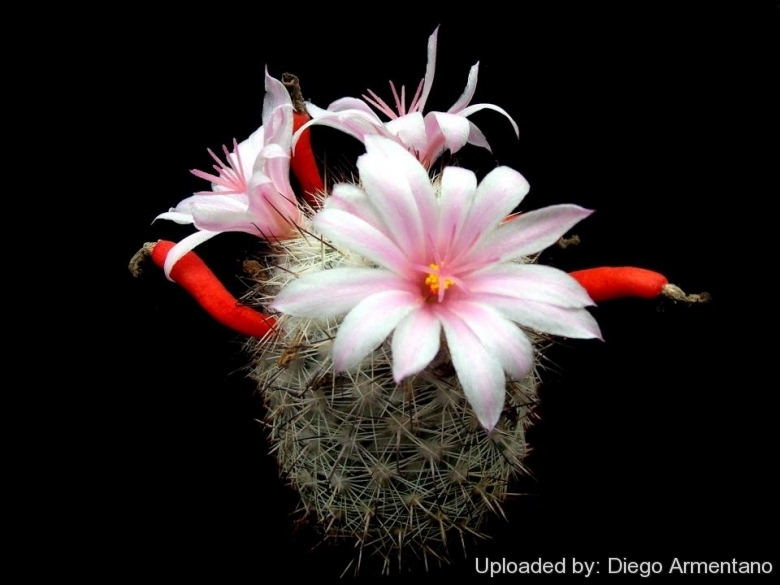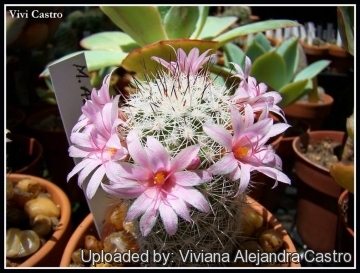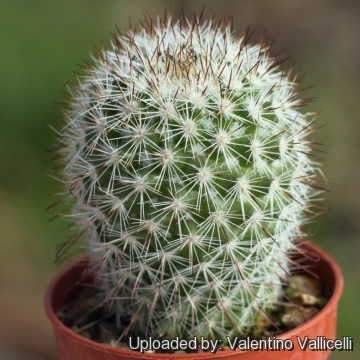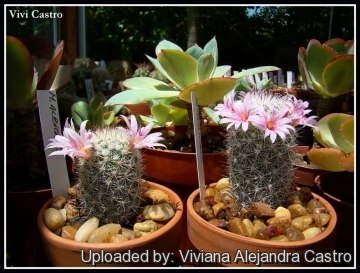Accepted Scientific Name: Mammillaria albicans (Britton & Rose) A.Berger
Kakteen (Berger) 308 (1929) (A.Berger)

Bartschella albicans (Mammillaria albicans) Photo by: Diego Armentano
Origin and Habitat: Mammillaria albicansSN|5348]]SN|5348]] has a very restricted range in the Baja California Peninsula on the mainland and various islands (San Francisco, San José, San Diego and Santa Cruz islands), Mexico. Its extent of occurrence is less than 500 km2.
Altitude: 10 to 200 metres above sea level.
Habitat: It grows on arid granite-based soils and rocky hillsides, in desert scrub (Lower Sonoran Zone) along with Mammillaria dioicaSN|5356]]SN|916]], Mammillaria fraileanaSN|916]]SN|5356]], Pachycereus pringleiSN|8572]]SN|8572]] and is very abundant on the islands where it occurs, but it tends to be scarce on the mainland. There are no known major threats for Mammillaria albicansSN|5348]]SN|5348]].
Synonyms:
See all synonyms of Mammillaria albicans
back
Accepted name in llifle Database:Mammillaria albicans (Britton & Rose) A.BergerKakteen (Berger) 308 (1929)Synonymy: 8
back
Common Names include:
UKRAINIAN (Українська): Мамілярія альбіканс
Description: Mammillaria albicansSN|5348]]SN|5348]] ia a clustering cylindrical cactus which arc densely covered with short white spines nearly obscuring the stem and often pure white. The plant can produce clumps of 5-15 branches.
Stem: At first globose but becoming cylindrical and then pale green, 10-20 cm tall, 3-6 cm in diameter branching basally.
Tubercles: Broadly conical, pale green, without latex, 5-6 mm broad at base, 4-5 mm long, closely crowded and obscured by spines. The axil is woolly, especially in the flowering zone and bears few bristles, white with dark brown tips.
Areoles: Densely white-woolly in youth.
Central spines: 3-4 (sometimes to 8), acicular, straight, stiff (sometimes one of the central spines is hooked), white pinkish to brownish with brown tips, 8-10 mm long.
Radial spines: 14-18(-21), slender, acicular, straight, stiff, widely spreading, closely interlaced, white, pinkish or pale brown, slightly darker to nearly black at tips 5 - 8 mm long.
Flowers: Around the top, white to pale pink, with pinkish mid-veins, up to 20 mm in diameter. Outer perianth segments pinkish. Stigma lobes pink to purplish.
Blooming season: Summer (June to August).
Fruits: Club-shaped, orange to red, 10-18 mm long.
Seeds: Nearly round, dull black with basal hilum.
Taxonomy note: Mammillaria sleviniiSN|5352]]SN|5352]] is synonymous of Mammillaria albicansSN|5348]]SN|5348]], they are are very similar, namely size and form of stems, shape of spines, flowers, etc. and the two plants are not readily distinguishable if not for the stems, simple or few branched (1-10 compared to 5-15 branched in M. albicans) moreover it has darker spines and the spine-areoles are not densely lanate.
Subspecies, varieties, forms and cultivars of plants belonging to the Mammillaria albicans group
 Mammillaria albicans (Britton & Rose) A.Berger: produces clumps of 5-15 branches with cylindrical stems closely crowded and obscured by spines . Areoles densely white-woolly in youth.
Mammillaria albicans (Britton & Rose) A.Berger: produces clumps of 5-15 branches with cylindrical stems closely crowded and obscured by spines . Areoles densely white-woolly in youth. Mammillaria slevinii (Britton & Rose) Boed. in Boed.: has stems, simple or few branched, darker spines and the spine-areoles are not densely lanate.
Mammillaria slevinii (Britton & Rose) Boed. in Boed.: has stems, simple or few branched, darker spines and the spine-areoles are not densely lanate.
Bibliography: Major references and further lectures
1) Edward Anderson “The Cactus family” Timber Press, Incorporated, 2001
2) James Cullen, Sabina G. Knees, H. Suzanne Cubey "The European Garden Flora Flowering Plants: A Manual for the Identification of Plants Cultivated in Europe, Both Out-of-Doors and Under Glass" Cambridge University Press, 11/Aug/2011
2) David R Hunt; Nigel P Taylor; Graham Charles; International Cactaceae Systematics Group. "The New Cactus Lexicon" dh books, 2006
3) John Pilbeam “Mammillaria: the cactus file handbook” Cirio Publishing Services Ltd Dec/30,/1999
4) León de la Luz, J.L., Hernández, H.M. & Gómez-Hinostrosa, C. 2013. Mammillaria albicans. In: IUCN 2013. "IUCN Red List of Threatened Species." Version 2013.2. <www.iucnredlist.org>. Downloaded on 03 January 2014.
5) Nathaniel Lord Britton, Joseph Nelson Rose “Cactaceae: Descriptions and Illustrations of Plants of the Cactus Family” vol. 4 The Carnegie Institution of Washington, Washington 1923
6) Forrest Shreve, Ira Loren Wiggins "Vegetation and Flora of the Sonoran Desert" Volume 1 Stanford University Press, 1964
 Bartschella albicans (Mammillaria albicans) Photo by: Viviana Alejandra Castro
Bartschella albicans (Mammillaria albicans) Photo by: Viviana Alejandra Castro Bartschella albicans (Mammillaria albicans) Photo by: Valentino Vallicelli
Bartschella albicans (Mammillaria albicans) Photo by: Valentino Vallicelli Bartschella albicans (Mammillaria albicans) Photo by: Viviana Alejandra Castro
Bartschella albicans (Mammillaria albicans) Photo by: Viviana Alejandra CastroSend a photo of this plant.The gallery now contains thousands of pictures, however it is possible to do even more. We are, of course, seeking photos of species not yet shown in the gallery but not only that, we are also looking for better pictures than those already present.
Read More... Cultivation and Propagation: Mammillaria albicansSN|5348]]SN|5348]] is slow-growing, and not especially easy to grow. Use pot with good drainage and a very porous mineral-based potting mix. Potted plants are quite wet-sensitive, especially in light of its small root system. Water sparingly during the growing season, keep very dry in winter. Feed with a high potassium fertilizer in summer.
Usually it is recommended to overwinter this plant in a bright and warm greenhouse with at least 8-10° C, but it has proved to be quite frost resistant (if kept dry, it's hardy as low as -5° C). Strong light is required for flowering.
Some plants will offset readily, and clumps can be produced in a very few years.
Propagation: Direct sow after last frost, or use cuttings.













